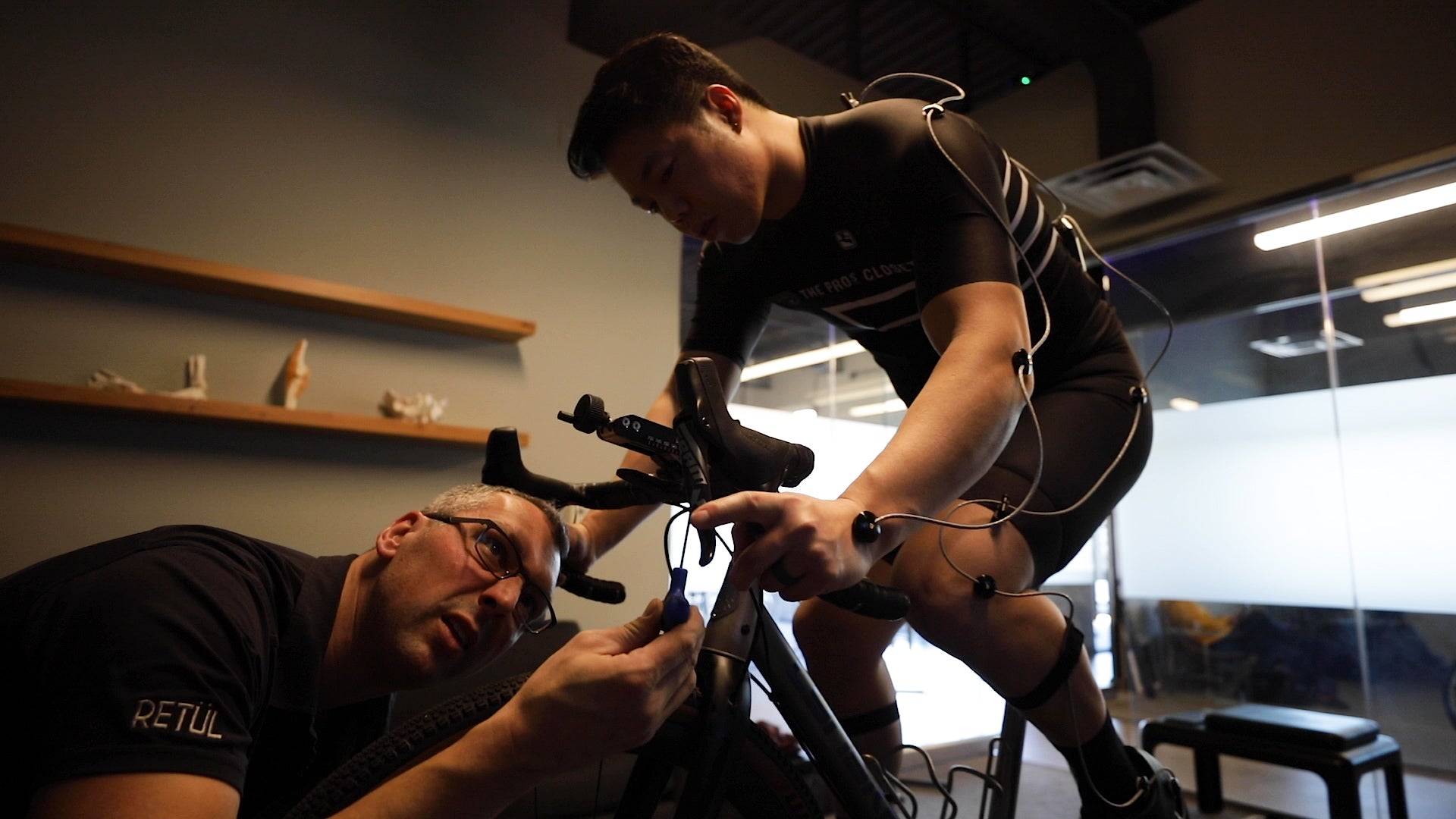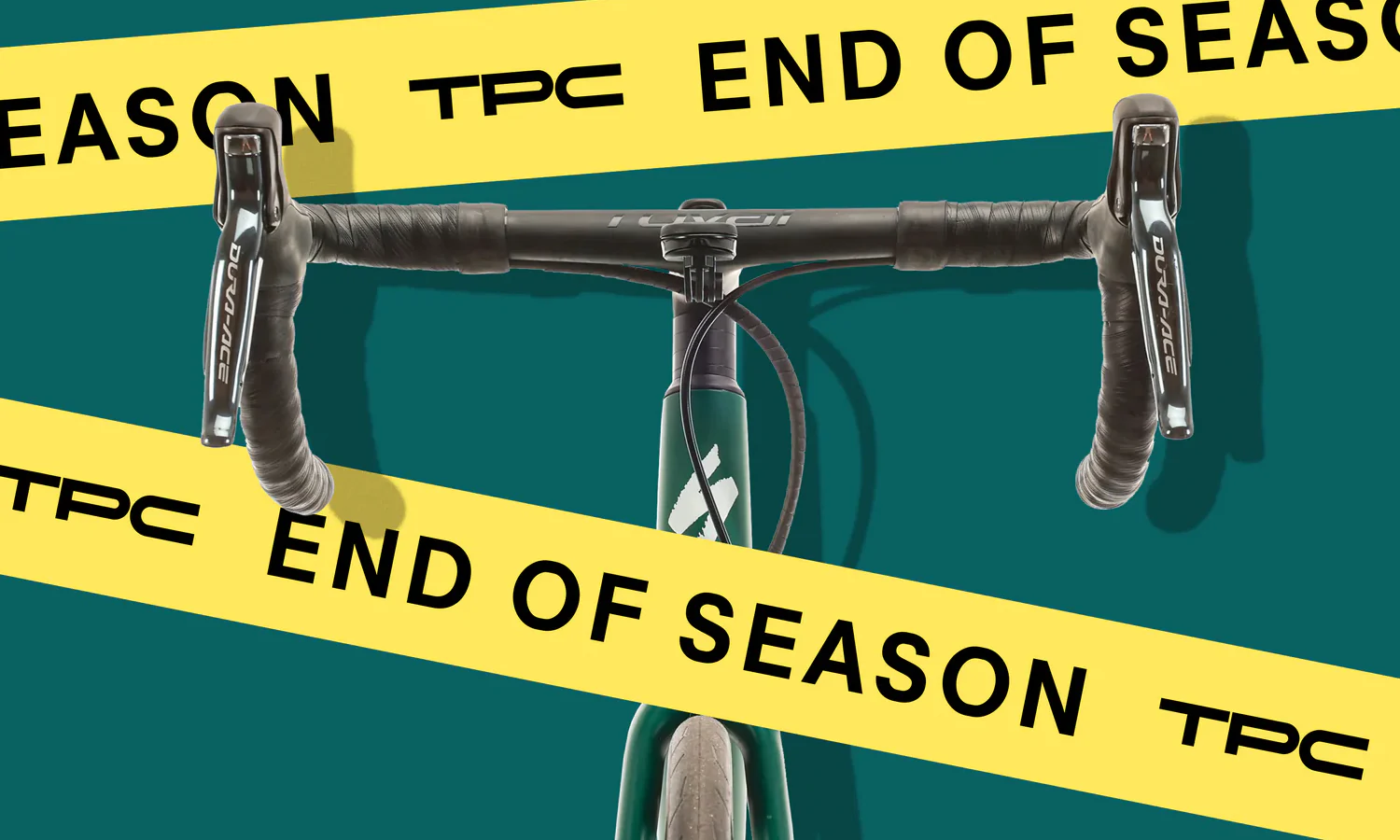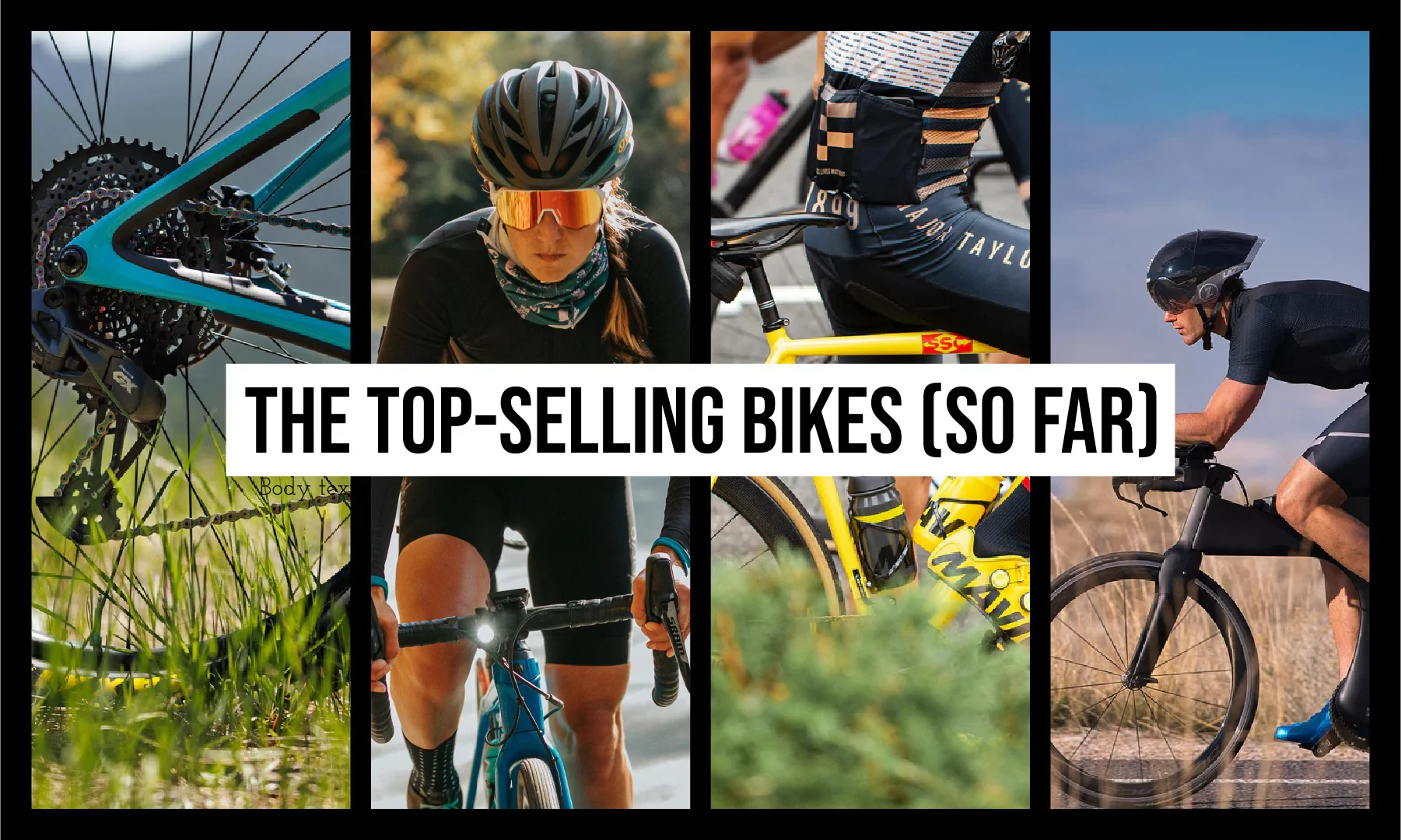So you’ve got your helmet, pedals, and other cycling essentials, and you’re having a blast exploring the open road. But maybe you’re wondering, “Can it get better?” It sounds like you're ready to get some upgrades! Modifying and personalizing your road bike and gear is one of the best parts of cycling. The 10 upgrades I’ve picked out here are the components and accessories that have made the biggest difference in my own ride. You probably don’t need all 10, but adding a couple of these upgrades to your own gear collection can help you go faster, climb better, ride longer, feel comfortable, and have more fun.
[button]SHOP ROAD BIKES[/button]
1. Comfortable saddle
 Cycling shorts with a good chamois vastly improve comfort, but it’s all for naught if your saddle is a literal pain in your butt. Whenever I get a new bike, the saddle is always the first thing I swap. My saddle of choice is the Fizik Vento Argo in the 150mm width. It’s a snub-nosed saddle with a short nose, a generous cutout, and a slightly curved shape. It fits my backside perfectly and is comfy enough for 200-mile rides.
Cycling shorts with a good chamois vastly improve comfort, but it’s all for naught if your saddle is a literal pain in your butt. Whenever I get a new bike, the saddle is always the first thing I swap. My saddle of choice is the Fizik Vento Argo in the 150mm width. It’s a snub-nosed saddle with a short nose, a generous cutout, and a slightly curved shape. It fits my backside perfectly and is comfy enough for 200-mile rides.
[product-block handle="fizik-vento-argo-r3-saddle-k-ium-rails-black"/]
Fizik offers several popular saddle shapes that suit different riders. Unfortunately, just because a saddle works for one rider doesn’t mean it will work for you. I had to buy and experiment with several different saddles until I found “the one.” You may have to as well.
You can get a solid starting point by measuring your sit bones to determine your ideal saddle width. There are a lot of methods you can look up online — I sat on tinfoil and measured the distance between the center of the dimples my sit bones created. My sit bones measure ~140mm so I use saddles in the 150-155mm range to get adequate support. Also, consider the saddle curve. Less flexible riders generally need a more curved saddle to cradle their sensitive bits when bending over to reach the bars. More flexible riders can take advantage of a flatter saddle that lets them shift back and forth to stay comfortable. If you’re struggling with numbness, consider a saddle with a cutout to relieve pressure.
[button]SHOP SADDLES[/button]
2. Dialed in cockpit
 Just because you’re riding the correct size bike, doesn’t mean the cockpit is set up for your particular proportions. Depending on your flexibility and torso length, you may find that your current cockpit makes your bike feel too stretched or too cramped. In fact, a large percentage of riders will need to change their stem to achieve a comfortable bike fit. Similarly, you may prefer wider or narrower handlebars, more flare in the drops, or different-shaped drops (e.g., compact vs. traditional round drops).
Just because you’re riding the correct size bike, doesn’t mean the cockpit is set up for your particular proportions. Depending on your flexibility and torso length, you may find that your current cockpit makes your bike feel too stretched or too cramped. In fact, a large percentage of riders will need to change their stem to achieve a comfortable bike fit. Similarly, you may prefer wider or narrower handlebars, more flare in the drops, or different-shaped drops (e.g., compact vs. traditional round drops).
[product-block handle="zipp-service-course-stem-31-8mm-clamp-6-degree-black"/]
Outside of dialing in your bike fit, upgrading your stem and handlebars can just be cool. It can add some serious bling to your bike, especially if you get a matching stem and bars. My dream cockpit is a full carbon ENVE stem and bar setup, but it’s a bit too pricey so all my drop-bar bikes are currently running Zipp cockpits, which I highly recommend. They’re stiff yet comfy, lightweight, and well-finished.
[product-block handle="zipp-sl-70-aero-handlebars-31-8-clamp-carbon-matte-black"/]
If you’re seeking more vibration damping for comfort, you can switch from aluminum to carbon handlebars or use cushier handlebar tape (my favorite is Lizard Skins DSP). If you seek speed, then aero handlebars will give you an edge, especially if they’re narrower than stock, which brings your arms in to reduce drag.
[button]SHOP STEMS[/button] | [button]SHOP HANDLEBARS[/button]
3. High-performance tires

If speed is the top priority, tires are the component that gives you the most gains for the least amount of money. Many road bikes are sold with mid-range training tires or budget basic tires that have more rolling resistance. High-performance tires usually have lighter and more supple casings that will roll much faster, so more of your energy goes toward propelling your bike forward. Supple tires also feel much more comfortable on rough roads and are more confidence-inspiring in corners. The main trade-off is often a shorter lifespan and less puncture resistance, but that’s often the price of going fast.
[product-block handle="vittoria-corsa-n-ext-g2-0-tire-700c-tubeless-black"/
[product-block handle="continental-grand-prix-5000s-tire-700c-220tpi-tubeless-black"/]
There are a lot of great tire options on the market, but I think the top two options are the Vittoria Corsa and the Continental Grand Prix 5000. These tires are favored by many pro riders, roll extremely fast, and have pretty decent puncture protection. They also come in both clincher and tubeless models. (On that note, switching to tubeless is another great upgrade idea.) The nylon casing Vittoria Corsa N.EXT is currently my favorite tire.
[button]SHOP TIRES[/button]
4. Professional bike fit

Many experienced riders would probably argue that a professional bike fit should be number one on this list. It’s possible to get your bike set up at home by feel or by using YouTube fit videos, but there are some more subtle nuances to bike fit that most riders probably aren’t aware of. A good bike fit can prevent common issues like knee pain, lower back pain, and numbness. Some fitters can guide you to select the ideal saddle and stem.
Not all bike fits are created equal. Having a bike shop guestimate your saddle height isn’t the same as getting fit at a studio using motion capture technology. Personally, I’m a fan of Retul’s high-tech fit methodology, and getting a Retul bike fit a couple of years ago made a huge improvement to my comfort on the bike. Best of all, my measurements were documented, so I’ve been able to replicate my fit on multiple bikes. Also, know that bike fits aren’t set in stone. You might find you need little tweaks out on the road, or as your fitness and flexibility change over time. But a good fit will give you a solid foundation for building mileage.
[button]LEARN ABOUT RETUL[/button]
5. Chain wax

If you care about your bike you should clean and lube its chain regularly. But if you want to maximize speed, nothing beats the performance of chain wax. I’m not talking about wax-based lubes, but rather immersion waxing and wax chain coatings. Wax reduces friction better than standard drip lubes, which saves you lots of watts. It also increases the longevity of your drivetrain, saving you money too. Plus, wax is super clean, so you can touch your chain without getting grease stains all over your skin or clothes.
Waxing a chain is a bit more complicated than regular lube because it requires removing the chain and fully stripping it of any pre-existing lubricants or grime. You then immerse the chain in melted wax or apply a wax chain coating. To learn more, check out my full write-up on chain waxing.
[product-block handle="silca-super-secret-chain-lube"/]
Currently, my favorite wax is Silca’s Super Secret chain coating. It’s easy to drip on after prepping my chain, and I think it works nearly as well as full-on immersion waxing. When prepping for a race though, I will give my chain a dunk in my slow cooker, which is currently filled with Molten Speed Wax.
[product-block handle="silca-synergetic-wet-lube"/]
For some riders, prepping and waxing a chain is just too complicated. If that’s the case, then Silca’s Synergetic Wet Lube is my favorite alternative. It’s still super fast, and I find a single application lasts nearly as long as a wax coating. Just know that since it’s a wet lube you will need to regularly wipe the grime that accumulates on your chain. I like Silca lubes because they’re not only fast, but they’re also PFAS-free and environmentally friendly.
[button]SHOP LUBES[/button]
6. High-quality sunglasses

I still remember getting my first pair of Oakleys. After riding in $5 gas station specials for years, the shocking clarity of a quality lens felt like I had upgraded my vision from 480p to 8k. Not only was the clarity surprisingly noticeable, but the definition was stunning. Modern lenses like Oakley’s Prizm lenses make surface changes, cracks, and debris on the road easier to see. I am fully serious when I say good eyewear actually makes the riding experience more pleasurable. I now have a big collection of Oakleys, but glasses from any manufacturer that specializes in eyewear and high-quality lenses will work great on the road. POC, Smith, and 100% are great options. If you’re on a budget, I’ve been very impressed with the quality of Tifosi glasses too.
[button]SHOP EYEWEAR[/button]
7. Aero helmet
 Back to speed gains again, and one of the best ways to cheat the wind is by using your head. A slippery aero helmet can save riders anywhere from 10-20 watts, which is a substantial gain. Plus, they just look super pro. Modern aero helmets are also great because they’re better ventilated than ever. I can wear my speedy Lazer Vento deep into the heat of summer.
Back to speed gains again, and one of the best ways to cheat the wind is by using your head. A slippery aero helmet can save riders anywhere from 10-20 watts, which is a substantial gain. Plus, they just look super pro. Modern aero helmets are also great because they’re better ventilated than ever. I can wear my speedy Lazer Vento deep into the heat of summer.
[product-block handle="lazer-vento-kineticore-bike-helmet-red"/]
On the hottest days or for big climbing days, I’ll bust out my POC Ventral which is specifically designed to use the venturi effect to draw air in over your head, making it one of the coolest aero helmets on the market.
[product-block handle="poc-ventral-spin-mips-lead-blue-matte"/]
These days, I wear an aero helmet on every ride because I don’t feel like I give up any comfort, and I get some easy aero gains in return.
[button]SHOP HELMETS[/button]
8. Carbon wheels
 Carbon wheels will transform any bike into a superbike — even budget aluminum road bikes. There’s a good reason every pro racer uses carbon and every one of my bikes at home rolls on carbon as well. Carbon wheels are lighter and stiffer than comparable aluminum wheels, which improves your acceleration and climbing speed. Some top-of-the-line carbon wheels can get under 1,200 grams, which is mind-blowingly light, while still being stiff enough to handle hard sprints.
Carbon wheels will transform any bike into a superbike — even budget aluminum road bikes. There’s a good reason every pro racer uses carbon and every one of my bikes at home rolls on carbon as well. Carbon wheels are lighter and stiffer than comparable aluminum wheels, which improves your acceleration and climbing speed. Some top-of-the-line carbon wheels can get under 1,200 grams, which is mind-blowingly light, while still being stiff enough to handle hard sprints.
Carbon can also be formed into deeper and more complex aero shapes to reduce drag. Aero experts figured out long ago that wheels, which make up the leading and trailing edges of your bike, are the key to maximizing aero gains. If speed on flat or rolling terrain is important to you, then deep-section 45-65mm wheels can turn your bike into a wind-cheating rocket.
So if I’m such a carbon wheel evangelist, why aren’t they higher on this list? The reason is the price. Carbon wheels are expensive. The top-of-the-line wheels that pros use can cost as much as a complete bike. Fortunately, there are plenty of budget and mid-range carbon wheels that can provide noticeable weight, stiffness, and aero gains for less.
[product-block handle="nc_enve-45-carbon-clincher-700c-wheelset-xdr"/]
I’m currently riding tubeless ENVE Foundation 45 wheels on my own road bike. These are ENVE’s first foray into lower-price wheelsets and they make a great do-it-all option. If you shop used or go with Chinese-made rims from a reputable brand (e.g., Light Bicycle), it’s possible to get a solid carbon wheelset for less than $1,000.
[button]SHOP CARBON WHEELS[/button]
9. Power meter

Quarq power meter on a SRAM Red AXS crank. Photo: Chris Milliman.
If you’re ready to get serious about training and improving your fitness, then a power meter is the most important tool you can add to your arsenal. Power meters measure how much work a cyclist is doing on the bike and express it in watts. It will allow you to monitor your workload, track progress, and pace efforts. Many training plans use power as the foundation for structured workouts. Measuring your power gives you accurate and consistent targets to hit during a ride so you can train effectively. By riding with power, you’ll improve faster and can target specific aspects of your fitness.
[product-block handle="garmin-rally-rk100-single-sensing-power-meter-pedals"/]
There are a few ways to add a power meter to your bike. The easiest way is simply installing a set of power meter pedals like the Garmin Rally pedals. These will work on any bike, and you can even swap them between different bikes in your quiver if needed. Otherwise, most modern power meters are crank based and will need to be matched to your specific crankset.
[button]SHOP POWER METERS[/button]
10. Nice bottles and cages
 If you’re looking for the perfect cherry to top off your upgrade sundae, then my pick is a good set of bottles and cages. Cheap cages make even the nicest bike look cheap too. Instead, I like to dress up my bikes with more modern-looking cages. For riders in the know, nice cages show that you care about the details. If you ride a smaller frame or want to fit massive bottles, upgrading also gives you the opportunity to swap in some handy side-load bottle cages.
If you’re looking for the perfect cherry to top off your upgrade sundae, then my pick is a good set of bottles and cages. Cheap cages make even the nicest bike look cheap too. Instead, I like to dress up my bikes with more modern-looking cages. For riders in the know, nice cages show that you care about the details. If you ride a smaller frame or want to fit massive bottles, upgrading also gives you the opportunity to swap in some handy side-load bottle cages.
[product-block handle="enve-carbon-bottle-cage"/]
If I want a cage to match my high-tech carbon bike, then I go for featherweight carbon cages from brands like ENVE and Arundel.
[product-block handle="silca-sicuro-titanium-bottle-cage-v2"/]
If I want a more classic look, then nothing beats a classy titanium cage.
[product-block handle="radavist-deserted-big-oasis-water-bottles-obsidian-pair"/]
If you have nice cages, then it makes sense to get a nice set of matching bottles too. My go-to for bottles has always been Purist. They keep my water tasting clean, have a no-nonsense leak-proof cap, and use an anti-microbial coating on the inside. Plus, they’re available with a ton of great designs that give your bike a bit of easy personalization.
[button]SHOP BOTTLES & CAGES[/button]













